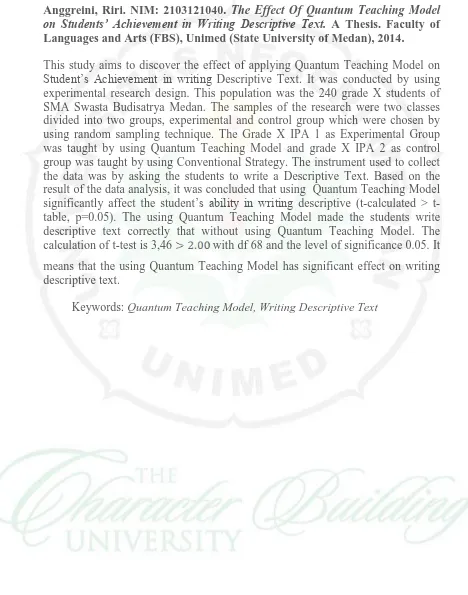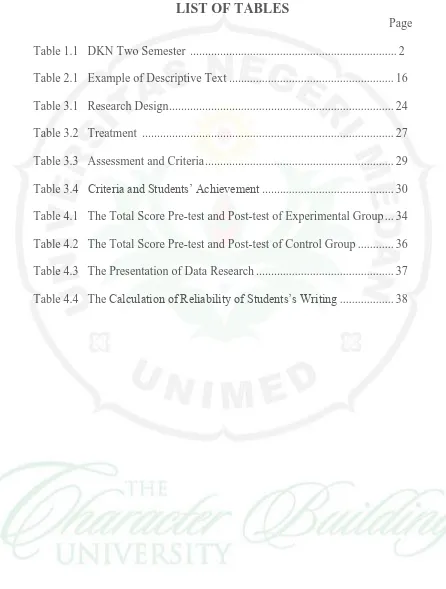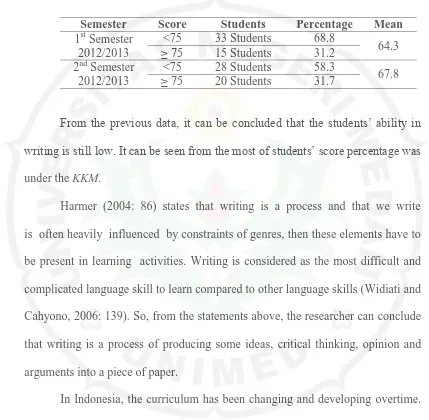THE EFFECT OF QUANTUM TEACHING MODEL ON
STUDENTS’ ACHIEVEMENT IN WRITING
DESCRIPTIVE TEXT
A THESIS
Submitted to English Department, Faculty of Language and Arts State University of Medan, in Partial Fulfillment of the Requirement for the
Degree of Sarjana Pendidikan
By:
RIRI ANGGREINI
Registration Number: 2103121040
ENGLISH AND LITERATURE DEPARTMENT
FACULTY OF LANGUAGES AND ARTS
DECLARATION
I have familiarized myself with the University’s Policy on Academic integrity. Except where appropriately acknowledged, this thesis is my own work, has been
expressed in my own words, and has not been previously been submitted for
assessment.
I understand that this paper may be screened electronically or otherwise for
plagiarism.
Medan, September 2014
i
ABSTRACT
Anggreini, Riri. NIM: 2103121040. The Effect Of Quantum Teaching Model on Students’ Achievement in Writing Descriptive Text. A Thesis. Faculty of Languages and Arts (FBS), Unimed (State University of Medan), 2014.
This study aims to discover the effect of applying Quantum Teaching Model on Student’s Achievement in writing Descriptive Text. It was conducted by using experimental research design. This population was the 240 grade X students of SMA Swasta Budisatrya Medan. The samples of the research were two classes divided into two groups, experimental and control group which were chosen by using random sampling technique. The Grade X IPA 1 as Experimental Group was taught by using Quantum Teaching Model and grade X IPA 2 as control group was taught by using Conventional Strategy. The instrument used to collect the data was by asking the students to write a Descriptive Text. Based on the result of the data analysis, it was concluded that using Quantum Teaching Model significantly affect the student’s ability in writing descriptive (calculated > t-table, p=0.05). The using Quantum Teaching Model made the students write descriptive text correctly that without using Quantum Teaching Model. The calculation of t-test is 3,46 with df 68 and the level of significance 0.05. It
means that the using Quantum Teaching Model has significant effect on writing descriptive text.
ii
ACKNOWLEDGEMENT
First and foremost, the writer would like to express thanks to Allah SWT, the Almighty God for Blessing, Health, Protection, knowledge and opportunity that at last she is able to complete this thesis entitled “The Effect of Quantum Teaching Model on Students’ Achievement in Writing Descriptive Text” as one of requirement for the degree of Sarjana Pendidikan (S1) at English Department, Faculty of Languages and Arts, State University of Medan.
This thesis could have not been accomplished without the guidance, helping, suggestion, advice, motivation and encouragement from people, for which the writer would like to express her extremely grateful which directed to:
Prof. Dr. Ibnu Hajar Damanik, M.Si, the Rector of State University of Medan.
Dr. Isda Pramuniati, M.Hum, the Dean of Languages and Arts Faculty. Prof. Dr. Hj. Sumarsih, M.Pd, the Head of English Department, and as
her Reviewers.
Rika, S.Pd, M.Hum as the Secretary of English Department.
Dra. Masitowarni Siregar, M.Ed, as the Head of English Education Study Program, and as her Reviewers
Dra. Yunita Agnes Sianipar,M.Hum, as her Thesis Consultant.
Drs. Johan Sinulingga, M.Pd as her Academic Consultant and her Reviewer.
G. Aziz, BA, the headmaster of SMA Swasta BudiSatrya Medan.
Alm. Rahmad Indra Utama and Maimunah Lubis, as her beloved parents, Ranti Rizky Utami as her beloved sister, Hj. Mariam Nasution, as her beloved grandmother, Saodah Lubis, Hj. Siti Multazam Dalimunthe , and Nurasiah Dalimunthe, S.Pd SD, as her beloved auntie, H. Ahmad Raja Lubis, MHD. Tahir, S.H, and Iman Martua Lubis as her beloved uncles, and all member of Lubis’s big family for their eternal material and moral supports, care, prayers, laughter, smiles, guidance, advices, best moments and love during the writers’ life.
iii
Nora Ronita Dewi, S.Pd, M.Hum, Marisi Debora, S.Pd, M.Hum, and Isli Iriani Pane, S.Pd, M.Hum, as her favorite lecturers, for the inspirations and spirits they give to the writer, and also Pak Hendra, Bu Endah, Bu Eis, Bu Ola, and Pak Pantas for their helps in arranging all documents for the study.
The last, but not the least, the writer would like to address a huge gratitude to Muhammad Azwar Fauzi Nasution, S.E, as her most flexible partner, her mood booster, her best friend, greatest brother, beloved father, worst enemy, and best life companion, for the supports, advices, laughter, smiles, long-night-talks, ideas, opinions, attention, prayers, knowledge, the teaching of life and many other things, and for always being there for the writer whenever she needs.
Medan, September 2014
The writer
Riri Anggreini
iv
LIST OF APPENDICES ... iv
CHAPTER I. INTRODUCTION ... 1
A. The Background of the Study ... 1
B. The Problem of the Study ... 5
C. The Objective of the Study ... 5
D. The Scope of the Study ... 6
E. The Significance of the Study ... 6
CHAPTER II. REVIEW OF LITERATURE ... 7
A. Theoretical Framework ... 7
1. Achievement in Writing ... 7
2. Students’ Achievement in Writing ... 8
3. Writing ... 10
a. Definition of Writing ... 10
b. Purposes of Writing ... 11
c. The Writing Process ... 12
4. Text ... 12
5. Types of Writing ... 14
6. Descriptive Text ... 16
a. The Definition of Descriptive Text ... 16
b. Generic Structure of Descriptive Text ... 16
c. Language Features of Descriptive Text ... 16
d. Example of Descriptive Text ... 17
v
a. The Main of Principles of Quantum Teaching ... 19
b. Quantum Teaching Framework... 19
c. The Framework of Quantum Teaching ... 21
d. The Advantages of Quantum Teaching ... 22
B. Conceptual Framework ... 23
C. Hypothesis ... 23
CHAPTER III. RESEARCH METHODOLOGY ... 25
A. Research Design ... 25
B. Population and Sample ... 26
1. Population ... 26
2. Sample ... 26
C. The Procedure of Research ... 27
1. Pre-test ... 27
2. Treatment ... 27
3. Post-test ... 29
D. Scoring of Test ... 30
E. The Validity and Reliability of The Test ... 31
1. Validity of the Test ... 31
2. Reliability of the Test ... 32
F. The Technique of Analyzing Data ... 33
G. The Statistical Hypothesis ... 34
CHAPTER IV. DATA ANALYSIS AND FINDINGS ... 35
A. The Data ... 35
B. Data Analysis ... 39
1. T-Test ... 39
2. Reliability of the Test ... 40
C. Testing Hypothesis ... 41
vi
CHAPTER V. CONCLUSIONS AND DISCUSSIONS ... 42
A. Conclusion ... 42
B. Suggestion ... 42
REFERENCES ... 43
vii
LIST OF TABLES
Page
Table 1.1 DKN Two Semester ... 2
Table 2.1 Example of Descriptive Text ... 16
Table 3.1 Research Design ... 24
Table 3.2 Treatment ... 27
Table 3.3 Assessment and Criteria ... 29
Table 3.4 Criteria and Students’ Achievement ... 30
Table 4.1 The Total Score Pre-test and Post-test of Experimental Group ... 34
Table 4.2 The Total Score Pre-test and Post-test of Control Group ... 36
Table 4.3 The Presentation of Data Research ... 37
viii
LIST OF APPENDICES
Page
Appendix 1. The Experimental Group Pre-test and Post-test Scores……... 44
Appendix 2. The Control Group Pre-test and Post-test Scores ……… 45
Appendix 3. Experimental Group Deviation Scores ... 46
Appendix 4. Control Group Deviation Scores ... 47
Appendix 5. The Result of Applied to the T-test Formula ... 48
Appendix 6. The Calculation of Reliability of Students’ Writing…………. 49
Appendix 7. The Reliability of the Test………..…. 50
Appendix 8. The Lesson Plan for Experimental Group ….……….. 51
43
REFERENCES
Arikunto, S. 2003. Prosedur Penelitian: Suatu Pendekatan Praktek. Jakarta: Rineka Cipta
Ary, Donald. 2002. Introduction to Research in Education. Singapore: Wardswith.
Bloom, B,S. 1996. Taxonomy of Educational Objectives: the Classification of educational Goals. New York; Longman.
Brown, H. Douglas. 2001 Teaching By Principle: An Interactive Approach to Language Pedagogy. (2nd ed). San Francisco: Addison Wesley Longman.
Chitravelu, et all. 2005. ELT Methodology: Principles and Practise 2nd Edition. Malaysia: Fajar Bekti
Clark and Clark. 1997. Physicology and Language. USA.Harcourt Brace Jovanovich.
DePorter, Bobbi. 2010. Quantum Teaching. Bandung : Kaifa
WENA, Made. 2011. Strategi Pembelajaran Inovatif Kontemporer. Jakarta: Bumi Aksara.
Harmer, J.2004. How to Teach Writing. London: Longman.
Heaton, J.1988. Writing English Test. London:Longman Group
Hyland, K.2003. Second Language Writing. New York: Cambridge University Press.
Hyland, K.2002. Teaching and Researching Writing. Great Britain: Longman.
1
CHAPTER I
INTRODUCTION
A. The Background of study
English nowadays is a need for many people in the world. That is why the
government of Indonesia put English as a subject in the education curriculum. In
the study of a language, there are four language skills that should be mastered by
the learners, and this is applied when one studies English. So, in educational
curriculum in Indonesia, the students should be able to master listening, speaking,
reading, and writing skills.
From the four language skills, writing is the focus on this thesis. Based on
preliminary observation conducted in SMA SWASTA BUDISATRYA Medan,
the researcher found that most of students of SMA SWASTA BUDISATRYA
Medan had problems in writing. They admitted that writing is difficult for them
and the implication, is they do not like to study English and they can not write a
good text. According to the teacher, the students are lack of ability in writing. It
was proved by The List of Students’ Score (DKN/Daftar Nilai Siswa) for writing
tests in two semesters. Many students could not pass The Minimal Completeness
Criterion (Kriteria Ketuntasan Minimum/KKM) applied by the school in English
subject. The KKM which is applied by the school is 75. Meanwhile, their DKN in
2
Table 1.1 DKN Two Semester
Semester Score Students Percentage Mean
1st Semester
writing is still low. It can be seen from the most of students’ score percentage was
under the KKM.
Harmer (2004: 86) states that writing is a process and that we write
is often heavily influenced by constraints of genres, then these elements have to
be present in learning activities. Writing is considered as the most difficult and
complicated language skill to learn compared to other language skills (Widiati and
Cahyono, 2006: 139). So, from the statements above, the researcher can conclude
that writing is a process of producing some ideas, critical thinking, opinion and
arguments into a piece of paper.
In Indonesia, the curriculum has been changing and developing overtime.
Ministry of Education and Culture of Indonesia has already published the new
curriculum for Indonesia’s education named the 2013 curriculum. Since this
experimental research is conducted in Senior High School grade X so School
3
Based on syllabus, there are several text that should be mastered by the
students. They are descriptive, procedure, recount, narrative and report text. In
this thesis the writer focuses on descriptive text.
Based on the observation and the interview that has been done, the writer
found some identification problems below.
1) The teacher method in teaching learning process in the classroom is
lecturing strategy. During the teaching learning process, the students
just sit and listen to the teacher without participate actively.
2) Due to the lack of knowledge of English, the students don’t really
understand and catch the explanation and instruction the teacher gives.
Therefore, they are misunderstanding of what the teacher said.
3) The students are lack of vocabularies, and still have low knowledge in
grammar and text genres. It makes them difficult to express their ideas
and thoughts in text form.
4) The last problem is the most important problem. Some students are shy
and lack of courage to ask the teacher when they don’t understand the
lesson. Besides, the teacher is vicious and it makes the students afraid
of the teacher. The teacher is always angry whenever the students
make mistakes and tell the students what is right rudely. So, instead of
understanding the lesson, the students are depressed during the lesson
and they got nothing when the lesson ended. And it happens
4
To solve the problems, the writer needs to find an effective strategy. Many
stategies can be applied into this genre to increase students’ achievement in
writing descriptive text, one of the strategies is Quantum Teaching Model.
Quantum Teaching Model is a comprehensive model that covers both educational
theory and immediate classroom implementation. It shows teacher how to
orchestrate students’ success by taking into account everything in the classroom
along with the environment.
De porter et.al (2004:5) explain that quantum Teaching is an interaction
that change energy into light. They conclude that Quantum Teaching is
orchestrating various interactions in teaching learning process. These interactions,
then change the ability and the talent of the students into “light” that will be useful
for them and others. They add that quantum teaching is the arrangement of a
studying with its nuance. It focuses on the dynamic relationship in the class
environment-interaction that builds and design- to study.
In line with that, the previous researcher Febriani (2012) has proved that
the Quantum Teaching Model can improve the students’ achievement in writing
descriptive text. She has proved that Quantum Teaching Model is one of strategy
which can be applied in teaching writing. She conducted a research in MAN 2
MODEL Medan and found that Quantum Teaching Model strategy improved
students’ achievement in writing descriptive text. It can help students to be more
active in class and help to increase students’ writing achievement from 68,08 to
74,70. It is proved that Quantum Teaching Model is one of promising strategy
5
Therefore, an appropriate model to teach writing to the students should be
able to be determined by the teacher in order to encourage the students to write a
good text. A popular model in teaching namely Quantum Teaching Model is
offered. In other words, Quantum Teaching implies interaction in teaching –
learning process conveying some elements. It will make the students study
effectively, which in the end will influence their success.
In line with the background above, the writer would like to conduct a
study with title : The Effect of Quantum Teaching Model on Students’
Achievement in Writing Descriptive Text. The writer expects to find the effect of
Quantum Teaching Model on students’ achievement in writing descriptive text.
B. The Problem of the Study
Based on the background of the study above, the problem of the study is
formulated as the following:
“Is there any significantly affect the application of Quantum Teaching
of Students’ Achievement in Writing Descriptive Text?” C. The Objective of the study
In relation to the research problem, this study is aimed to investigate
whether there is any significant effect of The Quantum Teaching Model on
6
D. The Scope of the study
There are several strategies that can be applied to improve students’ writing
achievement. This study focuses on the applying of Quantum Teaching Model to
improve students’ achievement in writing descriptive text. The object of the study
is limited on the senior high school students grade X at SMA SWASTA
BUDISATRYA Medan.
E. The Significance of the study Findings of this study are expected:
1. To motivate the students to be better in writing descriptive texts.
2. To help the teachers in finding the better teaching model particularly in
teaching of descriptive texts,
3. To increase the readers’ knowledge about Quantum Teaching Model
and descriptive text writing, and
4. To help the next researchers (teacher candidates) to apply a model in
teaching learning process and make it as a motivation especially in
42
CHAPTER V
CONCLUSIONS AND SUGGESTIONS
A. Conclusion
Based on the data analysis which are presented in the previous chapter,
the conclusion are dawn as the following:
1. The findings shows that the students’ achievement taught by Quantum
Teaching Model in writing descriptive texts is higher than the students
taught without applying the Quantum Teaching Model.
2. The findings shows that is higher than it means that the
proposed hypothesis is accepted.
3. The Quantum Teaching Model can improve the students’ achievement
writing, especially in writing descriptive texts.
B. Suggestion
Having considered the findings of this research, the suggestions are:
1. It is suggested that the teachers of English should apply the Quantum
Teaching Model as the model of teaching in teaching writing in order
to improve the students’ achievement in writing descriptive texts.
2. The teacher should also prepare various kinds of media for the


